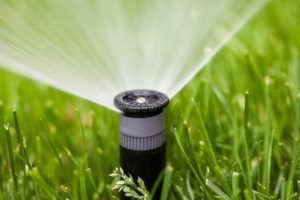Details Landscape Art is a Sonoma County landscape contractor, designing and installing beautiful gardens throughout the North Bay. Upon completion of a garden installation, we leave detailed watering and fertilization instructions with the homeowner. Our typical garden includes lawn and drip irrigation system for all lawns (if installed) and plant material (sometimes multiple drip valves or lines). The single most important key to the continued success of a garden is the automatic irrigation controller (pictured below). It allows the flexibility to use different programs to accommodate the different needs of the plant material installed.
When brand new plants are installed in a garden, no matter what container size they came from, the plants are babies, and have not established a root system in the ground. So we recommend that initially, the timer is set to run the drip system every day for about ten minutes, depending on the climate and time of year. Thirty days later, we suggest increasing the watering time to fifteen minutes, and only water every other day. Thirty days later, twenty minutes every third day, and so on until the roots are established. About six months after installation, the drip valves should run anywhere from thirty to forty minutes every five or six days. The idea is to wean the plants from daily watering, start to water more deeply to drive the roots deeper, and allow the plant to dry out in between waterings.
More plants die from over watering than any other reason. If a plant does not get enough water, it will droop and ask for a drink, and then perk up upon watering. A plant that is over watered does not have a second chance. The roots sit in a pool of water, get choked off from oxygen and dies from root rot.
Lawn sprinkler valves need to be set to water heavily for the first twelve to fifteen days after installation to establish a base root system. Thereafter, fifteen to twenty minutes every three to four days is usually sufficient. There are many types of lawn sprinklers. Some are designed to water large expanses of grass like parks or baseball fields. For smaller residential lawns we use what’s called fixed head sprayersthat reach from six to fifteen feet.  We install this type of lawn sprinkler system with what’s called head to head coverage. Each sprinkler head must throw water so that it reaches the next head since sprinklers don’t do a good job of watering right next to themselves. So the area around each head must receive water from the next head and so on.
We install this type of lawn sprinkler system with what’s called head to head coverage. Each sprinkler head must throw water so that it reaches the next head since sprinklers don’t do a good job of watering right next to themselves. So the area around each head must receive water from the next head and so on.
A garden’s plants may be irrigated either by installing multiple valves and multiple drip lines (one for shade, one for full sun, etc.). We prefer to use one line, and use a different size emitter for each plant depending on its water requirements.

For example, a rose in full sun loves water and needs a two gallon per hour emitter, while a manzanita right next to it in full sun will get a one gallon per hour emitter. A rhododendron in the shade will get a one gallon per hour emitter. That way, with a given watering duration, each plant receives the appropriate amount of water.
Again, these are not hard and fast rules. Much depends on the climate, time of year, temperature, availability of rainwater, and type of soil. Lawn and drip irrigation is not rocket science but requires some careful thought to irrigate correctly.
